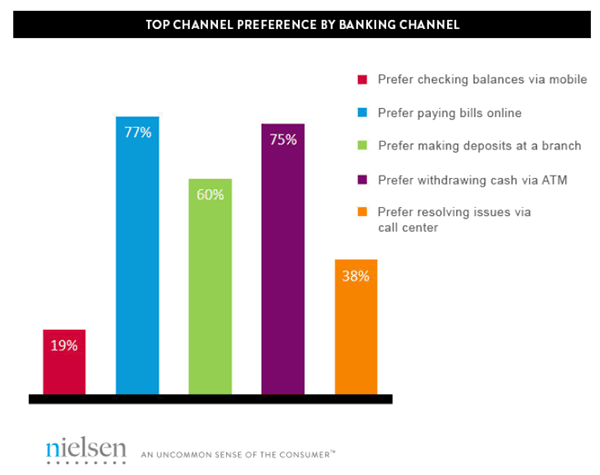One of the predominant drivers and challenges in retail banking across the globe is the ongoing evolution towards direct models and channels, predominantly digital channels.
According to Roland Berger Strategy Consultants, retail banking distribution channels will continue to evolve towards these more direct models and channels across Europe, even as the evolution has been going on for quite some time now. This will lead retail banks to (continue to) adopt more marketing techniques – again predominantly digital – to increase the percentage of new clients acquired via such direct channels. In other regions, the same phenomenon occurs. And the digital transformation challenges certainly are not just about marketing.
In a report on retail banking evolutions in the US, for instance, Capgemini wrote that “the growing influence and popularity of direct channels, supported by changing channel usage patterns, has resulted in a need for a role transformation of traditional channels such as the branches”.
Some of the main drivers of the emergence of direct channels are:
- technological/digital possibilities as such
- the need – and potential – to reduce costs and optimize efficiency and processes
- changing consumer demand and behavior (more empowered, digital and demanding)
- related with the above: the need to put the channel-agnostic consumer first and provide the right interaction possibilities and information when and where people want in a consistent way
- the advent of disruptive players, offering different experiences, products and channel strategies
- the increasing success of direct banking pureplayers
- dissapearing silos of data and telephony
Geographical differences regarding the impact of direct/digital channels in retail banking
There are important differences in the expectations of retail banking executives regarding the actual impact of direct channels, depending on the region, just as there are differences in the preferences consumers across the globe have regarding direct and digital channels. Below are some general data.
Note: direct channels are not just digital channels. Also the phone, for instance, remains an important channel. However, as the borders (and divisional silos) regarding telephony, data/networks and even the workplace (think unified communications and collaboration in this context), dissapear, it inreasingly becomes part of an overal digital transformation exercise as well.
Direct/digital channels and retail banking in Europe
In the previously mentioned report, Roland Berger Strategy Consultants explains some of these differences from the customer acquisition perspective across Europe:
- Especially retail banking executives from Central Europe expect to get more new clients via direct channels (58% of them expect to acquire over 20% more customers using these digital channels).
- Second comes Western Europe where 38% of respondents expect direct channels to account for over 20% of new customers.
- Eastern Europe ranks third (21%), leaving Southern Europe far behind.
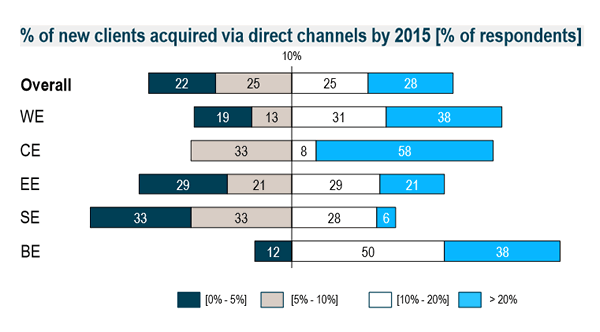
Direct/digital channels and retail banking in the US
According to research from Nielsen, 82% of US consumers banked online at least once in the last 30 days. In the same period, “only” 68% visited a physical branch. With online by far being the preferred – or at least, most often used – channel – the role of contact centers is declining while the role of mobile (now at 36%) is rapidly increasing).
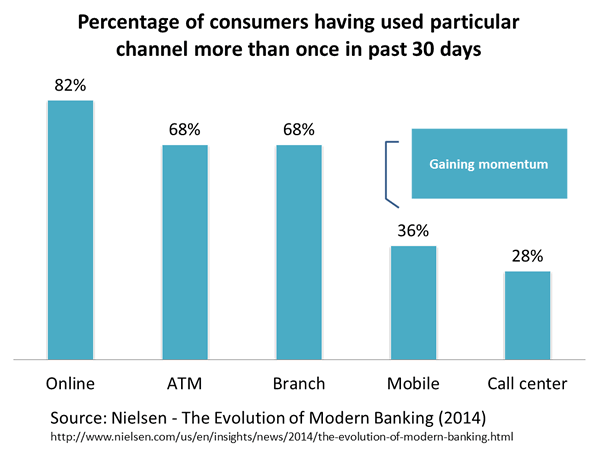
Direct/digital channels and retail banking in the Middle East and Africa
In the Middle East online banking is lagging behind. In the Gulf Cooperation Council Countries (GCC), for instance, only one third of all bank customers in the region had signed up for online services, AT Kearney wrote early 2013. Of those, approximately, 18% were also active online. However, the region is catching up and has vast growth opportunities for various reasons. AT Kearney, among others, mentions high Internet usage, changing consumer profiles and online behavior, the relatively low number of branches and the relatively low service levels in traditional channels, all opportunities for direct and digital channels.
Knowing that, according to Gartner, banking and securities firms are expanding and modernizing in the Middle East and Africa, and there is a shift from an oil based towards a services based economy in the GCC countries, whereby governments drive IT and transformation investments with a focus on citizens, this leads to even faster adoption. Sales, cost reducation and customer service were already among the key drivers of using online channels in the GCC countries, as the AT Kearney chart below shows.
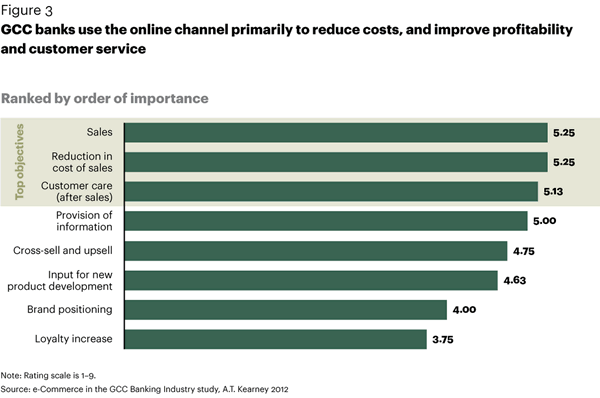
One of the phenomena showing changing priorities in the whole region is the relatively increase of business process outsourcing and IT services spending. Of course, MEAF, is a vast region and there are national differences. In some countries, for instance, mobile penetration is much higher than in others.
A global picture: digital and direct channels matter everywhere
In a bank consumer survey, conducted by Research Now and commissioned by CGI, North American and European financial consumers, showed the clear role of digital channels in today’s omnichannel reality. The report also emphasized that the use of and perception towards digital channels for banking is not generationally defined. As, CGI says, this means that – opposed to reality – banks should not just focus their digital strategies on Generation Y.
Direct and digital channels are simply a must for all retail banks that want to serve their customers, regardless of age and geography. It is a highly individual and contextual matter.
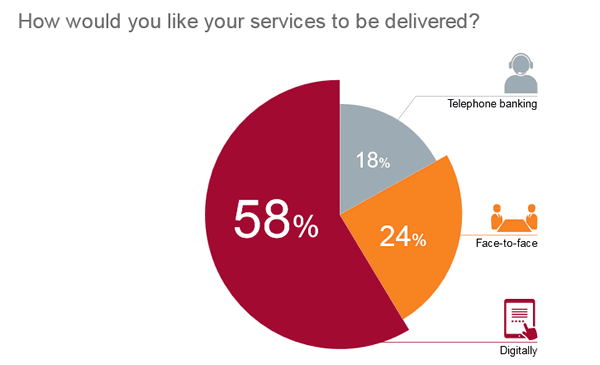
Digital and direct: the broader channel-agnostic retail banking perspective
The rise of direct and digital channels in retail banking, with an increasingly important role for mobile, obviously does not stand alone. Consumers are channel-agnostic and it’s clear that retail banks as a result need to align their channel distribution approach and move from multi-channel to omnichannel distribution strategies. Consumers do not think in terms of channels.
The need to align disitribution strategies isn’t new either but in reality, retail banks have quite some challenges making it de facto happen. On top of traditional integration and alignment issues, which we see in virtually all industries (silos, legacy systems, disconnected processes, a channel-centric mentality, culture,…), banks are confronted with well-known other transformational challenges in a digital context and of course specific challenges regarding legislation, security, etc.
Many of the transformational challenges in a digital context are directly related to the direct channels as such (think about mobile banking, which comes with specific security priorities too). Others are more related with the advent of new forms of payment and new models.
With face-to-face interaction and the “human touch” in retail banking remaining important, the customer-oriented channel mix is essential, looking at the customer life cycle rather than at individual behavior.
In a digital/direct context, for instance, it’s not about mobile or online (or telephony, for that matter): it’s about everything as the consumer is one.
Furthermore, consumers hop from channels to channels and expect a consistent banking experience. Which channel they use when and where is a matter of several contextual elements (e.g. which screen do they use at a specific moment in time) and that also includes the actual intent or task at hand. For some interactions, there is also a clear preference for specific channels as the chart below from the previously mentioned Nielsen report indicates.
